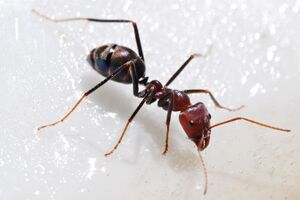Anteater
|
Anteater | ||||||||||||
| A fine specimen of the anteater. | ||||||||||||
| Scientific Classification | ||||||||||||
|
The Anteater is a strange-looking mammal belonging to the eater family. It is a distant relative of the Cookieeater and the Flying Purple People Eater, both of which are threatened with extinction by overexposure to the media. It is one of the only creatures on earth known for eating ants as a source of protein. Imitators such as the aardvark tend to be more fond of cheeseburgers, but unable to find any in the wild, they are forced to hunt ants due to the similar taste. The main difference between anteaters and aardvarks is that one of them looks like a deformed pig with donkey ears.
Anteaters are often subject to the misfortune of having the least creative name in the animal kingdom. Apparently whoever discovered them was too lazy to give them a better name. This was probably the same person who named the grasshopper and the woodpecker. On the plus side, however, this makes it easy to know what anteaters eat. If you don't know what they eat, then you are quite possibly an idiot.
Description[edit]
A typical anteater is covered with fur. It also bears a long curved head with a tube-shaped snout, which many people wrongly think is a trunk. As a result, anteaters are usually drawn to look like elephants, to which they are not related in any way. At the tip of the snout is the anteater's tiny mouth opening. Anteaters are toothless, so they never have to chew, brush or visit the dentist. But for what they lack in teeth, they make up for in long worm-like tongues with which they catch helpless ants and termites. Among other things.
Habitat[edit]
Anteaters are found exclusively in the rain forests and grasslands of Mexico, Central America, and South America. They commonly inhabit areas in or near places with a high ant population, such as picnic sites, a decaying whale carcass, and your kitchen floor.
Some lost, cold, hungry anteaters have occasionally been found in the shores of Antarctica, most likely because it has the word ant in its name despite having nothing to do with ants whatsoever. If it did have ants, then perhaps they evolved into penguins and learned how to swim. Anteaters can neither swim nor stuff a big, pudgy penguin into its tiny toothless mouth.
Hunting[edit]
A hungry anteater would approach an anthill and wait for the right moment to attack, even though anthills don't move. Then the anteater will bust in and slurp up as many ants as possible using its tongue. Any ant caught by the tongue will be pulled into the anteater's stomach - which some believe is actually a black hole which leads into another dimension. I don't know. I'm not an ant. Even if I were, I still wouldn't know because I would be dead.
Once the carnage is over, the anteater will then move to the next closest anthill to repeat the process. An anteater can eat at around 30,000 ants in a single day. This is probably because ants are tiny. They will also eat termites and the occasional antelope. Any other type of food is hazardous to the anteater's immune system and, if ingested, will cause the creature to puke and succumb to epilepsy.
Diet[edit]
Predators[edit]

A fully-grown anteater has few natural predators, most notably the Anteater-eater, a large carnivorous mammal which can easily kill any anteater in sight. Anteater-eating anteaters can also be a problem in parts of rural Spain. Anteaters are also careful to avoid anteater-eating ants so as to keep the food chain in natural balance. The anteater-eating burrito also used to be a threat until it was hunted to extinction in 1985.
Man-eating anteaters[edit]
Yet another monstrosity set upon the world by mad science, man-eating anteaters look very identical to the typical ant-eating anteaters. If you happen to come across an anteater you think is of the man-eating variety, there are a few precautions you could take to be sure. The best option is to throw a raw piece of chicken in the creature's face. It will either run away crying or eat the piece of meat. If by chance it's the latter, then it's a man-eater, in which case you should either run, beat it to death with a baseball bat, or call your neighbour and let the creature eat him while you make your daring escape.
A problem concerning man-eating anteaters is that they tend to make nests in suburban backyards. If you are faced with this problem, do not call an exterminator unless you want to be charged with murder. Instead, offer them steamed brussel sprouts. The creatures will either flee at the sight of the vegetables or die if consuming them, for their digestive systems are only suited to meat. And ants.
The future of anteaters[edit]
“Each time you don't kill an ant, you also don't kill an anteater.”
The growing number of ant infestations has lead to more demands for bug repellent, exterminators, fumigators, and magnifying glasses in an attempt to wipe ants off our planet forever, thus hindering the anteater's survival in the wild. Al Gore presented this scenario on his recent documentary Save the Ants, Save the Anteaters - released during Anteater Awareness Month - as means of foretelling the species' potential endangerment.
One effort being made to prevent the plight of both species is conservation programs encouraging people to buy pet anteaters. They unsurprisingly make convenient pest controllers. Unfortunately, they don't make very good pets, as they tend to throw loud parties at night and stick their long tongues into certain places you don't want them to.




